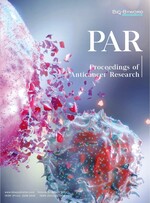CT Differentiation of Diffuse Malignant Peritoneal Mesothelioma, Tuberculous Peritonitis, and Peritoneal Carcinomatosis
Abstract
Objective: To investigate the significance of computed tomography findings in diffuse malignant peritoneal mesothelioma (DMPeM), tuberculous peritonitis (TBP), and peritoneal carcinomatosis (PC) to differentiate the three diseases. Methods: The clinical manifestation and computed tomography scans of 147 patients with diffuse malignant peritoneal mesothelioma (n = 60), tuberculous peritonitis (n = 32), and peritoneal carcinomatosis (n = 55) were retrospectively reviewed, while taking into account of ascites, pleural plaques, viscera infiltration; abnormalities in the peritoneum; involvement of the mesentery and omentum; as well as the presence and location of enlarged lymph nodes. Results: There was no significant difference among all three groups in terms of clinical manifestation, peritoneum, omentum, and mesentery involvement, ascites, as well as the presence and location of enlarged lymph nodes. The study found that 95% of DMPeM patients had been exposed to asbestos in the past. The patients showed significant differences in the following aspects: (1) irregular peritoneum thickening, caked omentum thickening, pleural plaques, visceral infiltration, and asbestos exposure were more common in peritoneal mesothelioma patients; (2) nodular peritoneum thickening and visceral metastasis were more common in patients with peritoneal carcinomatosis; (3) smooth peritoneal thickening, pleural effusion, and extraperitoneal tuberculosis were more common in patients with tuberculous peritonitis. Conclusion: A combination of computed tomography findings could improve our ability in differentiating the three diseases.
References
Runyon BA, Montano AA, Akriviadis EA, et al., 1992, The Serum-Ascites Albumin Gradient Is Superior to the Exudate-Transudate Concept in the Differential Diagnosis of Ascites. Ann Intern Med, 117: 215–220.
Zheng G, Wei S, Yen W, et al., 2011, Clinical Analysis of Percutaneous Peritoneal Biopsy in the Diagnosis of 200 Patients with Unexplained Ascites. Chin J Digest Med Imaged, 1(1): 29–32.
Yin WJ, Zheng GQ, Chen YF, et al., 2016, CT Differentiation of Malignant Peritoneal Mesothelioma and Tuberculous Peritonitis. Radiol Med, 121(4): 253–260.
Liang YF, Zheng GQ, Chen YF, et al., 2016, CT Differentiation of Diffuse Malignant Peritoneal Mesothelioma and Peritoneal Carcinomatosis. J Gastroenterol Hepatol, 31(4): 709–715.
Husain AN, Colby T, Ordonez N, et al., 2013, Guidelines for Pathologic Diagnosis of Malignant Mesothelioma: 2012 Update of the Consensus Statement from the International Mesothelioma Interest Group. Arch Pathol Lab Med, 137(5): 647–667.
Charoensak A, Nantavithya P, Apisarnthanarak P, 2012, Abdominal CT findings to Distinguish Between Tuberculous Peritonitis and Peritoneal Carcinomatosis. J Med Assoc Thai, 95(11): 1449–1456.
Coakley FV, Choi PH, Gougoutas CA, et al., 2002, Peritoneal Metastases: Detection with Spiral CT in Patients with Ovarian Carcer. Radiology, 223(2): 495–499.
Busch JM, Kruskal JB, Wu B, 2002, Armed Forces Institute of Pathology. Best Cases from the AFIP: Malignant Peritoneal Mesothelioma. Radiographics, 22: 1511–1515.
Spirtas R, Heineman EF, Bernstein L, et al., 1994, Malignant Mesothelioma: Attributable Risk of Asbestos Exposure. Occup Environ Med, 51: 804–811.
Selikoff IJ, Hammond EC, Seidman H, 1980, Latency of Asbestos Disease Among Insulation Workers in the United States and Canada. Cancer, 46: 2736–2740.
Wei SC, Zheng GQ, Wang ZG, et al., 2013, The Retrospective Analysis of Clinical Data in 162 Malignant Peritoneum Mesothelioma Cases in Cangzhou. Chinese Journal of Internal Medicine, 52: 599–601.
Su SS, Zheng GQ, Liu YG, et al., 2016, Malignant Peritoneum Mesothelioma with Hepatic Involvement: A Single Institution Experience in 5 Patients and Review of the Literature. Gastroenterol Res Pract, 2016: 6242149.
Sugarbaker PH, Welch LS, Mohamed F, et al., 2003, A Review of Peritoneal Mesothelioma at the Washington Cancer Institute. Surg Oncol Clin N Am, 12: 605–621.
Baratti D, Kusamura S, Cabras AD, et al., 2010, Lymph Node Metastases in Diffuse Malignant Peritoneal Mesothelioma. Ann Surg Oncol, 17(1): 45–53.
Zissin R, Hertz M, Shapiro-Feinberg M, et al., 2001, Primary Serious Papillary Carcinoma of the Peritoneum: CT Findings. Clin Radiol, 56(9): 740–745.
Souza FF, Jagganathan J, Ramayia N, et al., 2010, Recurrent Malignant Peritoneal Mesothelioma: Radiological Manifestations. Abdom Imaging, 35(3): 315–321.
Thoeni RF, Margulis AR, 1979, Gastrointestinal Tuberculosis. Semin Roentgenol, 14: 2.
Hunlick DH, Megibow AJ, Naidich DP, et al., 1985, Abdominal Tuberculosis: CT Evaluation. Radiology, 157: 199–204.
Na-ChiangMai W, Pojchamarnwiputh S, Lertprasertsuke N, et al., 2008, CT Findings of Tuberculous Peritonitis. Singapore Med J, 49(6): 488.
Jain R, Sawhney S, Bhargava DK, et al., 1995, Diagnosis of Abdominal Tuberculosis: Sonographic Findings in Patients with Early Disease. AJR, 165: 1391–1395.
Leder RA, Low VH, 1995, Tuberculosis of the Abdomen. Radiol Clin North Am, 33: 691–705.
Pickhardt PJ, Bhalla S, 2005, Primary Neoplasms of Peritoneal and Sub-Peritoneal Origin: CT Findings. RadioGraphics, 25: 983–995.
Ha HK, Jung JI, Lee MS, et al., 1996, CT Differentiation of Tuberculous Peritonitis and Peritoneal Carcinomatosis. AJR, 167: 743–748.

